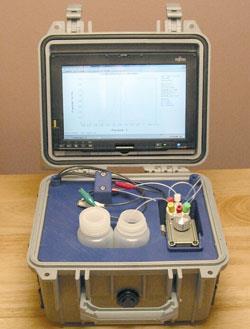Magnetic nanoparticles key to detecting heavy metals in minutes

Scientists in the US have developed a cheap lunchbox-sized device that can detect exposure to toxic metals in minutes.
The Pacific Northwest National Laboratory (PNNL) team have combined magnetic nanoparticles with electrochemical detectors to measure levels of lead and other toxic metals in biological samples like blood, urine and saliva. The battery-powered, field-portable device could be used to routinely monitor high risk groups such as industrial workers, and individuals living in polluted areas, so that any exposure can quickly be treated.
Accurately assessing lead levels in biological samples currently requires the use of mass spectrometers (ICP-MS) - large, expensive machines based in centralised analytical labs. Portable systems have the potential to provide results much faster - but current systems can’t provide the necessary accuracy, particularly in complex biological mixtures like blood or urine, said PNNL team leader Wassana Yantasee.
Yantasee was able to overcome the accuracy problems using superparamagnetic iron oxide nanoparticles, coated with dimercaptosuccinic acid (DMSA). Any lead in the sample rapidly binds to the DMSA’s sulfur side groups - and then can be detected electrochemically via an electromagnetic electrode, which the nanoparticles stick to thanks to their iron oxide core.
’The test takes only three to four minutes,’ said team toxicologist Charles Timchalk. ’And it does have excellent sensitivity - in the case of lead we’re detecting down to parts per billion, it’s very comparable to ICP-MS. The biggest problem we’ve faced is dealing with background lead contamination in our samples.’
The device, whose development has been supported by the US National Institute of Health, is designed to be simple to use. ’The user wouldn’t need a huge amount of technical skill - they wouldn’t have to be chemists,’ said Timchalk. ’Our vision is to have the devices available to public health nurses for testing in schools, or industrial hygienists in an occupational setting.’
The team are now trying to find a commercial partner to help market their device. ’We’ve had a conversation with a few companies, but nothing has yet materialised - but the list of potential interest is increasing,’ said Timchalk. ’It’s important to us that this technology doesn’t just sit in a laboratory, but that we find a means to get it out there, applied and used.’
’This is an extremely elegant piece of analytical work, neatly combining surface modification chemistry with magnetic particle separation and sensitive electroanalytical detection,’ Richard Compton, who researches electroanalysis at Oxford University, UK, told Chemistry World. ’The detection limits are impressive and, in particular, the challenge of working quantitatively on the substrates studied cannot be over-emphasised.’
James Mitchell Crow
References
W Yantasee et al, Analyst, 2008 DOI: 10.1039/b711199a
W Yantasee et al, Environ. Health Perspect., 2007, 115, 1683






No comments yet